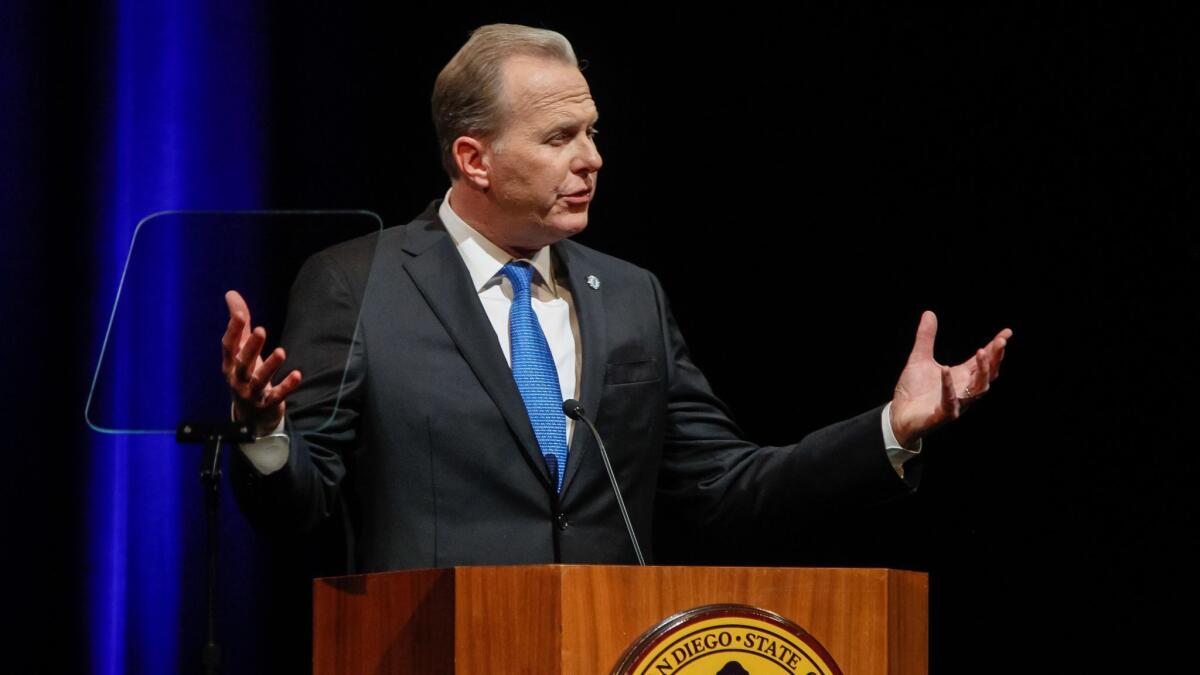Mayor Faulconer’s housing speech sounded good, but will it work?

Housing advocates are pleased with the mayor’s pledge to make it easier to build homes in the city, but there are issues that concern market experts.
In last week’s State of the City address, Mayor Kevin Faulconer said he would use several measures to encourage more building, such as eliminating height limits in neighborhoods outside the coastal zone, wipe out parking requirements and streamline approvals for many projects, including low-income housing, as long as properties are within a half-mile of an existing or planned trolley or bus line.
Coupled with Gov. Gavin Newsom’s recent budget proposal threatening to withhold state tax dollars for communities that don’t approve enough housing, it represents a new day for housing advocates.
“On its own, it sounds like a complete sea change,” said Nathan Moeder, principal with real estate analysts London Moeder Advisors, of the mayor’s proposal. “It sounds like (Faulconer) is really going to do everything in his power to create more housing.”
The sentiment was echoed by San Diego builders who reacted to the mayor’s speech with initial shock and awe, which has since settled into tempered enthusiasm.
“Waiving height limits, density maximums and parking minimums are game-changing concepts,” said Gilman Bishop, who runs the local development firm Bishop & Company, a specialist in urban infill projects.
The result could be a spike in what some call naturally occurring affordable housing, or residences that are cheaper than going market rates but not subsidized by governments. The equation breaks down like this: No parking restrictions plus no height limits equals lots of small apartments.
“Smaller units with less parking will naturally rent for less than larger, more appointed units with more parking, thus the mayor’s policy objectives should produce more housing for low- and moderate-income households,” Bishop said.
The building formula is gaining popularity in downtown San Diego where some developers are forgoing parking where possible.
For instance, real estate investment firm HP Investors is working on two projects, one in Little Italy and one in East Village, that will consist entirely of micro units — or 300-square-foot studios with kitchens and bathrooms — intended for neighborhood workers such as restaurant servers and bartenders. The projects are expected to offer between 50 and 75 units a piece, and all on 5,000-square-foot lots complete with rooftop decks and lounges.
The projects promote the downtown lifestyle and offer no resident parking, said HP Investors managing partner Sumeet Parekh. Units will be less expensive than in neighboring, new-construction buildings. Micro units rent from $1,300 to $2,000, and Parekh expects that his company’s units will fall in that range.
Such projects are tiny compared to the countywide housing problem, experts say. That, in part, explains their skepticism about the mayor’s housing agenda. The issues, as outlined in a report by London Moeder Advisors, start with this: The city of San Diego already builds much more housing for its population than anywhere else in the county. So while an increase of housing in the city is welcomed by advocates, it doesn’t mean North County will increase production.
From 1998 to 2017, San Diego built 43.6 percent of new housing units while growing cities like Poway contributed less than 1 percent to the county’s housing stock.
North County’s reticence to add homes is perhaps best evidenced by the Newland Sierra project, a 2,135-unit housing development along Interstate 15. The San Diego County Board of Supervisors approved it last year, but community groups have threatened to kill it by referendum.
While Newland Sierra gathers dust, other projects like it might have more luck. Ray Major, chief economist at the San Diego Association of Governments, said he was counting on political pressure from Sacramento to help.
“I think we are going to see pressure from the state of California to have other areas built out also,” he said, referencing Newsom’s speech.
Even with new laws, it will ultimately depend on where buyers and renters want to live and what developers can sell, said Ryan Ratcliff, associate professor of economics at the University of San Diego. He said the reality is that Californians still want a single-family home, and not everyone wants to live in a dense development near public transit.
“We have (this idea), ‘I’m going to have my single-family home, I’m going to get in my car and drive to work and that’s how my whole perception of how my life’s supposed to work,’” he said. “Changing that psychology on an individual level is something I’m concerned about.”
The mayor’s proposal comes at the end of a major building boom in San Diego. Last year, more than 2,000 apartments opened downtown, but this year there are roughly 900 scheduled to open.
Reasons for the decline given by analysts include market saturation downtown, a slowdown in rent increases or wage growth not keeping up with rents. At the same time, fluctuating steel prices — which rose dramatically since the Trump administration announced tariffs, but have gone back down — have given some developers pause on future projects.
James Weber, director of cost estimating for Xpera Group who tracks steel and labor costs, said there will probably be a lull in building downtown until the mayor’s proposal gains traction.
“I think once the approval is provided on Mayor Faulconer’s (plan), it will spark some added interest,” he said. “Investors will then be able to say, ‘Yes, I think this is a good idea. We should do this project.’”
Parekh agreed, adding that the mayor’s message will entice developers to take a second look at sites if they can cut back on parking and add units. Building by right, meaning without requiring extra public input, is also an attractive pitch.
Still, a proposal from City Council President Georgette Gomez to force builders to include low-income housing in new developments could undermine the mayor’s housing agenda, said Borre Winckel, CEO of the local Building Industry Association. The City Council is still waiting on a report from Keyser Marston Associates to analyze the effect of the proposal, but Winckel said he believed such a mandate would increase rents in new buildings.
“If you go from 10 percent of a building required for low-income units to 15 or 20 percent, you have just raised the rent of all the other units to carry that,” he said. “Are there still enough people in San Diego to absorb the significant increase from the number of affordable units in that building?”
Moeder said for the mayor’s plans to succeed, elected officials will need political cover for them to approve projects that their constituents show up to rally against.
“The problem is we haven’t had political will to vote against your own constituencies,” he said. “So, I will be waiting to see what tools (the mayor) proposes to actually entice politicians to vote for more density.”
phillip.molnar@sduniontribune.com (619) 293-1891 Twitter: @phillipmolnar
ALSO
San Diego’s new single-family homes are pricey, modern and in short supply
Tijuana condo craze continues in to 2018
Last year’s housing market broke records








